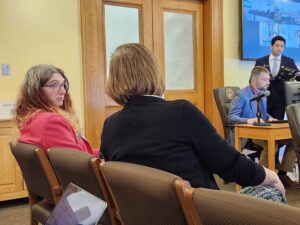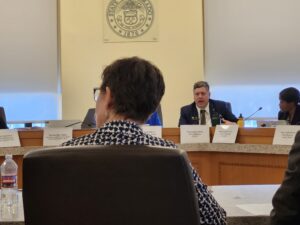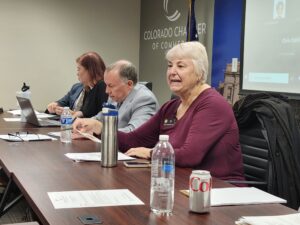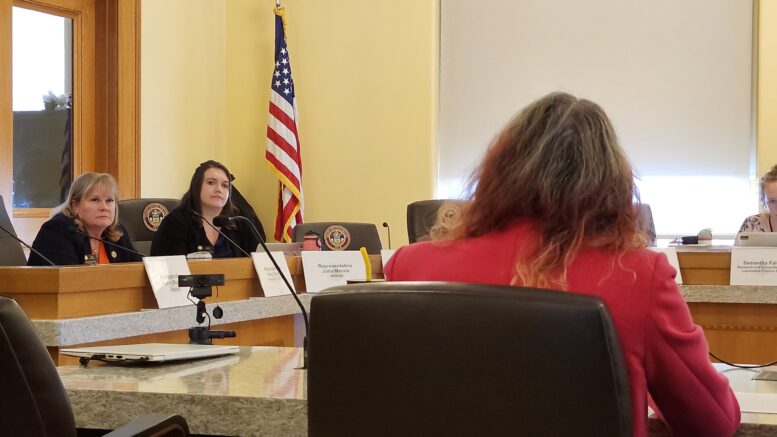As Colorado aims to achieve 100% net-zero greenhouse-gas emissions by 2050, leaders of key state agencies argue that they can’t meet that goal without employing carbon-capture-and-sequestration techniques in hard-to-decarbonize sectors.
But several environmental advocates — sometimes pitted against fellow environmental organizations — are pushing back against that idea and against a bill to clarify the state’s purview over geologic-storage operations. And that ideological infighting extended Wednesday to the House Energy & Environment Committee, which postponed until at least later this week a vote on a measure that could streamline permitting of carbon-capture efforts and define the previously untouched area of pore-space ownership.
Co-sponsoring Democratic Reps. Brianna Titone of Arvada and Karen McCormick of Longmont say House Bill 1346 is a follow-up to 2023 laws that redefined the mission of the former Colorado Oil and Gas Conservation Commission and let the state seek regulatory primacy from the U.S. Environmental Protection Agency for Class VI injection wells.
The renamed Colorado Energy and Carbon Management Commission could, if it receives EPA approval, license and regulate wells in which carbon is sequestered from the atmosphere and pumped into underground pore space forever. But it needs clarification on its ability to regulate related activities like test bores, monitoring wells and flow lines, as well as definition on who owns the underground space, which the bill states is the owner of the surface rights.
Colorado Energy Office among bill’s supporters
Taking all those steps outlined in HB 1346 would both allow more efficient permitting of carbon-capture efforts and would ensure the state could develop its own public-health and -safety regulations, Titone argued. Assistant Colorado Attorney General Lauren Mercer noted too that laws passed last year require those regulations to be stricter than the EPA’s, particularly in how they mandate the CECMC deny operating permits for injection sites near disproportionately impacted communities if the facilities have a net negative impact on those areas.

Colorado state Rep. Brianna Titone talks with House Bill 1346 cosponsoring Rep. Karen McCormick during a committee hearing on Wednesday.
“This bill will both enable and help with regulating responsibly Colorado’s carbon-management industry,” said Colorado Energy Office Executive Director Will Toor, adding that carbon storage is a strategy in the state’s new emissions-reduction roadmap. “We need all tools available to us.”
Not only is carbon storage necessary for capturing and ridding the air of emissions that either are taken from industrial pipes — or, in the future, will be pulled directly from the air — but it’s been proven effective, said Anna Littlefield, Colorado School of Mines’ carbon capture utilization and sequestration program manager. Ensuring the state has tools to allow and regulate such operations as fossil-fuel usage continues for the foreseeable future is a “strategic step to expediting the process,” she told committee members.
Environmental groups seek guardrail amendments
Environmental groups’ enthusiasm for carbon capture can be called tepid at best, as several balanced acknowledgements of its air-cleaning ability for hard-to-decarbonize sectors with the fact that its existence indicates continued emissions from fossil fuels. As such, organizations including Conservation Colorado, the Colorado Sierra Club and the Environmental Defense Fund asked that the committee add several amendments to HB 1346 to permit the efforts but also ensure the state builds proper public-health and -safety guardrails around any injection operations.
The main amendment, which Titone and McCormick are expected to offer this week, would add to the bill a proposed definition of cumulative impacts that CECMC must consider in a one-square-mile area around facilities when deciding whether to permit such operations. That definition encompasses the operations’ effect on public health and the environment — including impacts to air quality, water quality, noise, odor and wildlife — and allows officials to consider both adverse and beneficial impacts.
Another key change to the bill would remove CECMC’s ability to permit and regulate direct-air-capture facilities that would pull emissions from the atmosphere, a largely unproven technology that still has generated some excitement from policy makers. Toor said he asked sponsors to get that out of the bill for now because his office is studying the potential of direct air capture in meeting climate goals, and he plans to come back with a report on that by November.

Colorado state Rep. Alex Valdez probes carbon-capture experts Wednesday about how the process works.
Several environmental advocates, such as Boulder County Senior Assistant Attorney Kate Burke, also said cumulative impacts should be determined over a larger area than the one-square-mile a pending amendment proscribes. Some others pressed for clarification that carbon injected into wells couldn’t be used in enhanced oil recovery, though bill backers said such oil-production-aiding techniques already are banned for Class VI wells.
Carbon-storage bill could impact coming rulemaking
CECMC Chairman Jeff Robbins noted that the proposed definition of cumulative impacts that many groups want to include in the bill would impact not just carbon-capture operations but any operations, including oil and gas wells, permitted by his agency. CECMC officials are scheduled to hold rulemaking from April 22-26 to craft a definition of “cumulative impacts” to be applied to permitting decisions, but legislative direction on a specific new definition likely would stall that rulemaking for months.
Thus, many environmental groups asked sponsors to add to the bill the “robust accountability” that Conservation Colorado Climate Campaign Manager Paul Sherman described. But some said the state should back away from carbon capture altogether and kill the bill.
Several, such as Chuck Kutscher, a fellow and senior research associate of the University of Colorado Boulder Renewable and Sustainable Energy Institute, argued that the only way to property remove carbon from the atmosphere is by leaving it in the ground.
And others said the Legislature should not give CECMC more regulatory authority while it continues to allow more permits for oil-and-gas drilling even as the northern Front Range is in severe nonattainment of EPA ozone limits. CECMC officials told an interim committee studying ozone pollution that they have changed the way they approach their work over the past five years and work closely with applicants to lessen environmental impacts before approving permits, but Larimer Alliance representative Doug Henderson called it a “Trojan Horse” to justify more drilling.
Some groups simply oppose carbon-storage bill
“ECMC should not be entrusted with additional public responsibilities,” Henderson said. “ECMC is just a rebranded COGCC — an agency with a lineage of siding with oil and gas interests. It’s an example of an agency captured by the industry it regulates.”
Several committee members appeared torn on how to vote Wednesday, which likely led to sponsors asking for another week to work on amendments and try to generate support.

Colorado state Rep. Cathy Kipp speaks to a Colorado Chamber of Commerce policy council about some of her bills in January.
Rep. Cathy Kipp, a Fort Collins Democrat and chairwoman of the committee, asked why legislators needed to hurry to pass the bill this year rather than waiting for more study of carbon-capture technology. Mike Rigby, carbon-storage program coordinator for the CECMC, said he expects more Class VI well permit applications to come quickly, and gaining regulatory authority over them could help the state determine its own regulations.
Meanwhile, Rep. Stephanie Vigil, D-Colorado Springs, asked what in the bill incentivizes CECMC to scrutinize and deny permits — a question that evoked Mercer’s answer about state rules being required to be stricter than federal rules in several areas.
And Kipp asked what authority local governments could have over carbon-sequestration facility siting. That prompted Mercer to note that local governments have equal control over surface location and that her office has proposed an amendment that would require CECMC to consult with any local government overlies underground storage reservoirs.
